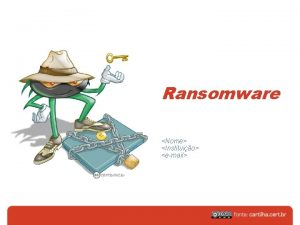Defend Against Ransomware Dont let ransomware kidnap you












- Slides: 12

Defend Against Ransomware Don’t let ransomware kidnap you. Info-Tech Research Group, Inc. is a global leader in providing IT research and advice. Info-Tech’s products and services combine actionable insight and relevant advice with Info-Tech's products and services combine actionable insight and advice ready-to-use tools and templates that cover the fullrelevant spectrum of IT with concerns. and templates that cover the full spectrum IT concerns. © 1997 -2016 Info-Tech Group © of 1997 -2016 Info-Tech Research Group Research Inc. Info-Tech Research Group 1

ANALYST PERSPECTIVE Crypto ransomware may be the most effective attack type ever! With the latest versions of crypto ransomware employing advanced encryption algorithms targeted at both organizations and consumers, ransomware has the potential to be the most impactful cyberattack ever. Never before has an attack type such as this been as disruptive to its victims nor garner as much profit for its attackers. This combination of effectiveness and profitability can lead to staggering attack rates. What is most frustrating about ransomware is that it can be responded to and even prevented relatively easily. It is not much different from other malware families. Until organizations put the time and funds into security and resiliency best practices, ransomware proliferation will continue. Wesley Mc. Pherson Research Manager – Security, Risk & Compliance Info-Tech Research Group 2

Our understanding of the problem This Research is Is Designed For: This Research Will Help You: üCISOs, CSOs, or other heads of security üUnderstand what ransomware is and its departments üIT security professionals characteristics üUnderstand how it is used and what tactics are employed by ransomware users üUnderstand how to prepare for and prevent a ransomware attack üUnderstand how to detect, respond to, and recover from a ransomware attack This Research Will Also Assist: This Research Will Help You: Them: üCIOs, IT directors, or other IT professionals üUnderstand what ransomware is, how it works, with security responsibilities üCEOs, Chief Legal Counsel, risk managers, and other roles with risk management functions and who uses it üUnderstand the potential impact and likelihood of that impact on their organization Info-Tech Research Group 3

Executive summary Situation Info-Tech Insight Ransomware has exploded in popularity among financially motivated threat actors. The total number of users who encountered ransomware grew 17. 7% from 2015 to 2016. The number of users infected with crypto ransomware grew 5. 5 times and mobile ransomware grew 4 times from 2015 to 2016. 1 1. It’s malware. Ransomware, although unique in its end goal, is still malware and can be defended against accordingly. Conventional controls can still apply. Complication 2. Don’t pay. After evaluating all possible outcomes if you become infected, payment should not be an option. • Recent advancements in crypto ransomware combined with the latest • delivery methods have proven to be extremely effective in denying access and soliciting a payment. Ransomware has the potential to be the most effective malware to realize a financial gain. Resolution • Stop worrying about becoming the next ransomware headline. Make the necessary preparations to defend your • • • organization against ransomware. Use this research to take a proactive stance to combat this risk by understanding what the threat is, who is committing these acts, what vulnerabilities are being exploited, and what/who is being targeted. Many conventional information security best practices can defend against a ransomware attack. You just need to make sure you have everything you need in place. Use this research to understand the necessary controls to defend against ransomware, and more importantly, to understand how to right-size those controls for your organization. 1 “KSN Report: Ransomware in 2014 -2016 ” Info-Tech Research Group 4

Info-Tech offers various levels of support to best suit your needs DIY Toolkit “Our team has already made this critical project a priority, and we have the time and capability, but some guidance along the way would be helpful. ” Guided Implementation Workshop Consulting “Our team knows that we need to fix a process, but we need assistance to determine where to focus. Some check-ins along the way would help keep us on track. ” “We need to hit the ground running and get this project kicked off immediately. Our team has the ability to take this over once we get a framework and strategy in place. ” “Our team does not have the time or the knowledge to take this project on. We need assistance through the entirety of this project. ” Diagnostics and consistent frameworks used throughout all four options Info-Tech Research Group 5

PHASE Introduction to Ransomware 1 Info-Tech Research Group 6

What is ransomware? Ransomware, in one simple sentence, is a type of malware that infects a system and restricts the user’s access to that infected system. The main points to highlight: • Ransomware is a generic term used for a family of malware that attempts to extort money from a user, locking either their system or some of their data and alerting them that if they pay a ransom, they will get access back. • Ransomware is an access-denial attack type of malware. • Ransomware uses fear and panic as its primary tactic to coerce its victims to pay, often known as “scareware. ” • Ransomware is a type of malware with many variants in the wild that can be used for a wide spectrum of purposes, ranging from financial extortion to cyberespionage. • Ransomware is spread like most other malware: drive-by downloads, phishing emails, SQL injections, etc. • Most ransoms are under $500 and usually require payment through a crypto currency such as Bitcoin. To security professionals today, ransomware can be two things: 1. A terrible headache where access to critical data or systems is lost, resulting in potential organizational process disruptions, direct financial costs, and/or public reputation damages. 2. Something your CIO or CEO read about and is now demanding information on how the organization is protected. In either case, this research will help arm you with the information and actionable steps to secure your organization from ransomware. Info-Tech Research Group 7

Ransomware is different from traditional malware or traditional attacks Ransomware may be a form of malware, but it is different in how it acts as malware and the types of attacks where it is used. Traditional Malware • • Defined as malicious software that looks to damage or disable a system. Mostly designed to gather sensitive information or gain access to systems. Often stealthy in nature. Designed to spy on users or cause some harm. Traditional Attacks • • Ransomware Differences • • Does not look to steal any sensitive information but instead to limit access to it. Does not try to remain undetected and instead (after certain points in the kill chain) it will actively notify victims of its presence. Financially-motivated attacks look for economic gain through theft of sensitive or confidential data that can then be resold. Sabotage attacks look to alter normal processes to elicit a destructive function. Ransomware Attacks • • Financially-motivated ransomware attacks are based on what can be disrupted instead of what can be stolen and then resold. Sabotage ransomware attacks introduce new functions to degrade functionality instead of modifying existing functions. Info-Tech Research Group 8

There are two types of prevalent ransomware today: locker ransomware and crypto ransomware Locker Ransomware Crypto Ransomware • Malware family that restricts the victim’s access to the infected system. • Often access is restricted by either: o limiting the function or denying access to the user interface, or o degrading or limiting the availability of the system’s computing resources. • Will often keep system data unaffected and instead only restricts access to the data. • Victims are often notified through the use of a full-screen image displaying demands for some ransom to be payed to return the system to normal functions. • According to Symantec, about 36% of binary-based ransomware detected in 2014 -2015 was locker ransomware (The evolution of ransomware). • Malware family that looks to restrict access to victim’s data or information. • Access is restricted by encrypting any sensitive or critical data and thus rendering it unreadable and unusable. • A ransom is demanded to receive the decryption key, which is needed to recover the data. • Will encrypt either sensitive data such as documents, spreadsheets, pictures or videos, or will encrypt critical operational data such as user credential directory. • Victims are often notified either by direct contact from the attackers or finding a digital note where the encrypted data resides explaining the compromise. • Encryptions can’t easily be deciphered, making crypto more dangerous. Both follow a similar pattern 1 Malware arrives on victim’s computer or system 2 Locker Ransomware: Locks the victim’s screen or system 2 Crypto Ransomware: Finds data and encrypts it 3 Victim notified of compromise through ransom note Info-Tech Research Group 9

Digital extortion tactics and ransomware have a longer history than most would expect 1989 2000 2006 2008 2012 2013 • The first ransomware actually dates back to the late 1980 s. Joseph Popp passed around some 20, 000 infected floppy disks at the 1989 World Health Organization AIDS conference. After 90 boots of the computer, the malware would hide the directory and/or encrypt files on the C: drive. Users were informed they were infected and that they had to send $189 to PC Cyborg Corporations at a P. O. box in Panama to free their system. • In the early 2000 s, fake spyware removal tools were used by opportunistic hackers to extort funds from unsuspecting targets. Actors exaggerated the impact of potential computer issues resulting from having spyware. This included things such as unused registry entries and corrupt files. The actors claimed to be able to resolve this issue if the user paid them a license fee – usually between $30 to $90. • In 2006, a precursor to modern crypto ransomware emerged. The Trojan. Gpcoder family of malware used weak symmetric encryption and was easily detected. Other variants, such as Trojan. Cryzip and Trojan. Arhieveus, emerged. According to Symantec, “Cryzip copied data files into individual password-protected archive files and then deleted the originals” (“The evolution of ransomware”). • In 2008 and 2009, actors began creating fake antivirus software. The fake programs performed fake scans that indicated threats (malware infection or software problem) to the computer were detected and that if the victim paid a license fee, usually $40 to $100, they would fix the problem. • In 2008, the first locker ransomware was seen: Trojan. Ransom. C spoofed a Windows Security Center message and alerted the user to call a premium rate phone number to reactive their license. Locker ransomware blocks access to the device but does not encrypt or delete any data. • By 2012, locker ransomware surpassed fake software schemes with attack types being spread en masse. Often attacks claimed to be law enforcement agencies that had locked down a computer because the user had performed some illegal action, such as download pirated music. • Locker ransomware began to decline between 2012 and 2014 as more users became aware of its tactics and more law enforcement agencies put efforts and resources into disrupting locker ransomware actors. In addition, APTs (Advanced Persistent Threats) became common vocabulary for many, increasing security awareness of social engineering tactics. • From 2013 to today, crypto ransomware has seen huge increases with stronger encryption algorithms being used (such as RSA, 3 -DES, and AES) and targets ranging from individual personal users to full enterprise systems. Crypto ransomware is the most effective at causing disruption, often with the only option to pay. Info-Tech Research Group 10

Timeline of the evolution of extortion tactics and ransomware • Trojan. Gpcoder • Trojan. Cryzip • Trojan. Arhieveus First Crypto Ransomware AIDS Trojan 1989 2000 Fake Spyware Removal Tools 2006 Fake AV Tools emerge • Locker ransomware beats out fake software scams Fake AV Crypto Locker dominates Ransomware extortion tactics dominates 2008 2010 First Locker Ransomware 2012 2013 Rise of Crypto Ransomware Dominant Extortion Tactic • Use of Bitcoin for payment Misleading Apps 2005 -2009 Fake AV 2010 -2011 Lockers 2012 -2013 2014 • For pay ransomware services • Targeted attacks Ransomware as a Service 2015 2016 Ransomware with exploit kits • Exploit kits (e. g. Angler) and web ads used Crypto Ransomware 2014 -Present Sources: Microsoft. “The 5 Ws and 1 H of Ransomware” Symantec. “The evolution of ransomware” Symantec. “An ISTR Special Report: Ransomware and Businesses 2016 ” Info-Tech Research Group 11

Info-Tech Research Group Helps IT Professionals To: ü ü ü Quickly get up to speed with new technologies ü Manage business expectations ü Justify IT spending and prove the value of IT ü Train IT staff and effectively manage an IT department Make the right technology purchasing decisions – fast Deliver critical IT projects, on time and within budget Sign up for free trial membership to get practical solutions for your IT challenges • “Info-Tech helps me to be proactive instead of reactive – a cardinal rule in a stable and leading edge IT environment. - ARCS Commercial Mortgage Co. , LP Toll Free: 1 -888 -670 -8889 Info-Tech Research Group www. infotech. com 12
 He who defends everything defends nothing
He who defends everything defends nothing Dont ask dont tell political cartoon
Dont ask dont tell political cartoon Don't laugh at me allen shamblin
Don't laugh at me allen shamblin Let me let me let me
Let me let me let me Describe the scenario that led prince paris to kidnap helen
Describe the scenario that led prince paris to kidnap helen Kidnap for ransom investigation procedures
Kidnap for ransom investigation procedures You cant manage what you dont measure
You cant manage what you dont measure If you can't measure it you can't manage it quote
If you can't measure it you can't manage it quote Matthew 6:14 images
Matthew 6:14 images Clip clop don't stop
Clip clop don't stop What you dont know wont hurt
What you dont know wont hurt If you dont know where to go
If you dont know where to go When life kicks you let it kick you forward
When life kicks you let it kick you forward























